- Home
- About
- Student Led
- Research Informed
- Practice Focused
- Resources
- News
- Green Campus Podcasts
- Case Studies
- Green Labs Community
News
Fast Fashion & Climate Justice
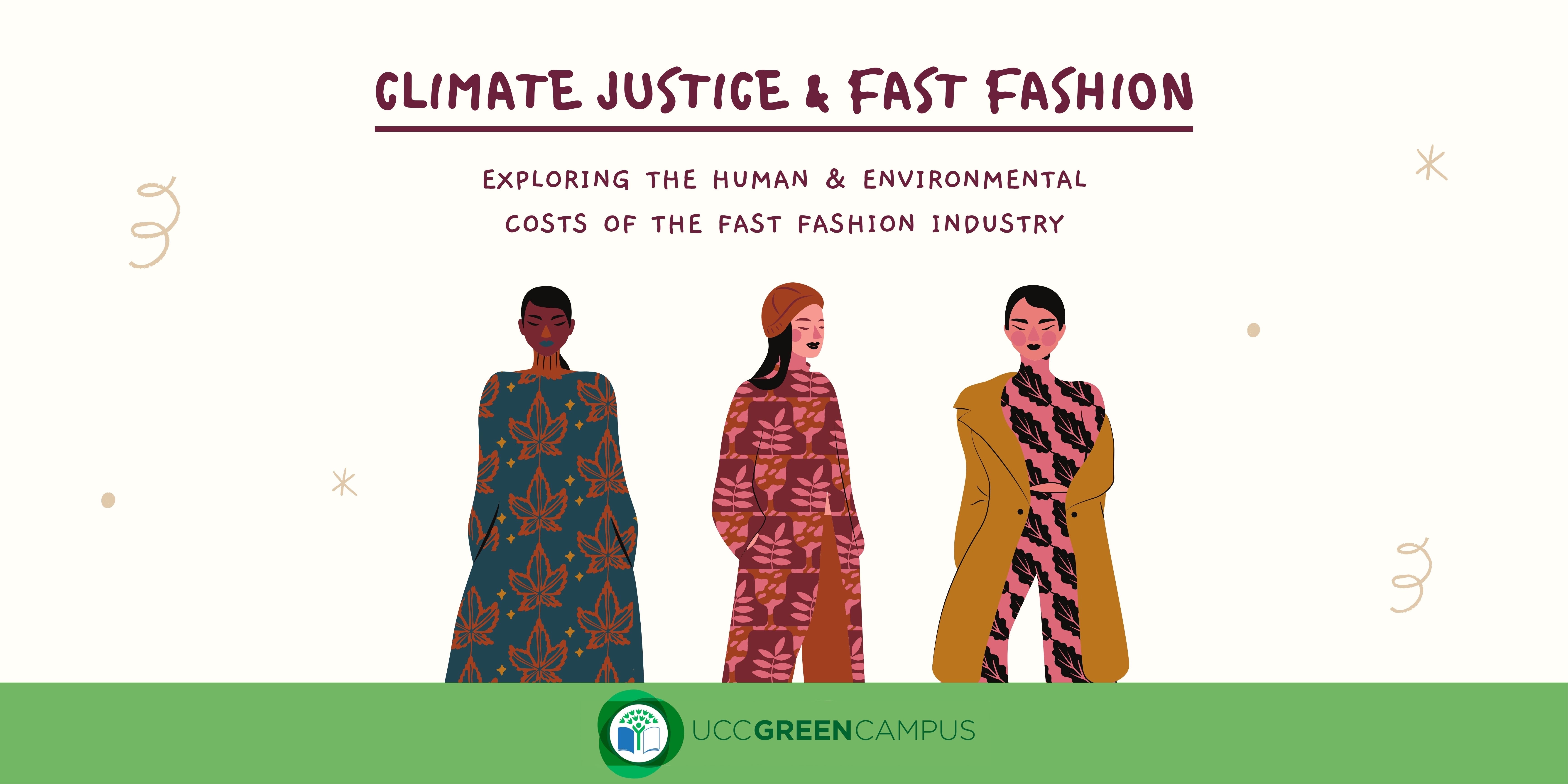
The next climate justice topic we’re going to be delving into is fast fashion. The boom of the fast fashion industry has had detrimental impacts on the planet and the workers it exploits. It is both unethical and unsustainable, and if we want to reach critical climate targets we must integrate climate justice into our fashion industry.
In this article, we’re going to discuss what fast fashion is, how it's harmful, and what you can do about it.
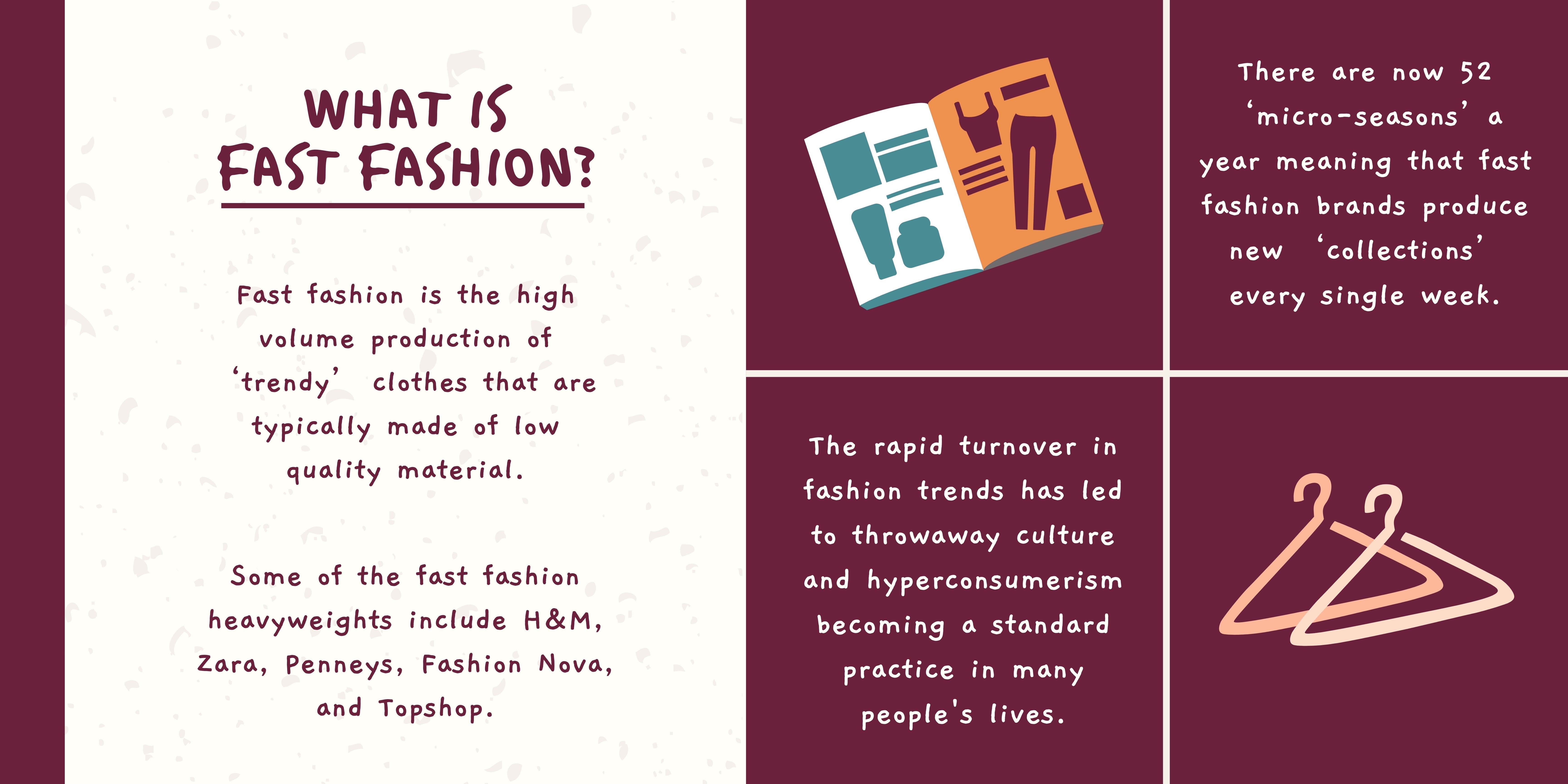
So what exactly is fast fashion?
Fast fashion is the high volume production of ‘trendy’ clothes that are typically made of low quality material. The fast fashion industry takes inspiration from high-end luxury brands and celebrity fashion and brings these trends to the high street as quickly and cheaply as possible. Some of the fast fashion heavyweights include H&M, Zara, Penneys, Fashion Nova, and Topshop.
The fashion industry has undergone huge changes over the past century[1]. Globalisation has skyrocketed fast fashion production and there are now 52 ‘micro-seasons’ a year meaning that fast fashion brands produce new ‘collections’ every single week[2]. These micro-trends have exacerbated the disposable nature of fast fashion which has resulted in people wearing items as few as seven to ten times before throwing them away[3].This rapid turnover in trends has led to throwaway culture and hyperconsumerism becoming a standard practice in many people's lives.
Social media platforms such as Instagram and TikTok are huge contributors to fast fashion. When social media influencers start a trend, retailers respond to the demand and supply massive amounts of ‘trendy’ clothes. However, as fast as these trends appear, they disappear almost as quickly leading to excessive amounts of garment waste[1]. Massive fashion hauls[2] have also become common-place online which glorifies overconsumption of fast fashion.
It’s common for fast fashion garments to be made from synthetic fibres like polyester and nylon, which are derived from fossil fuels. Furthermore, these clothes are not made to last which just makes the problem all the more worse.
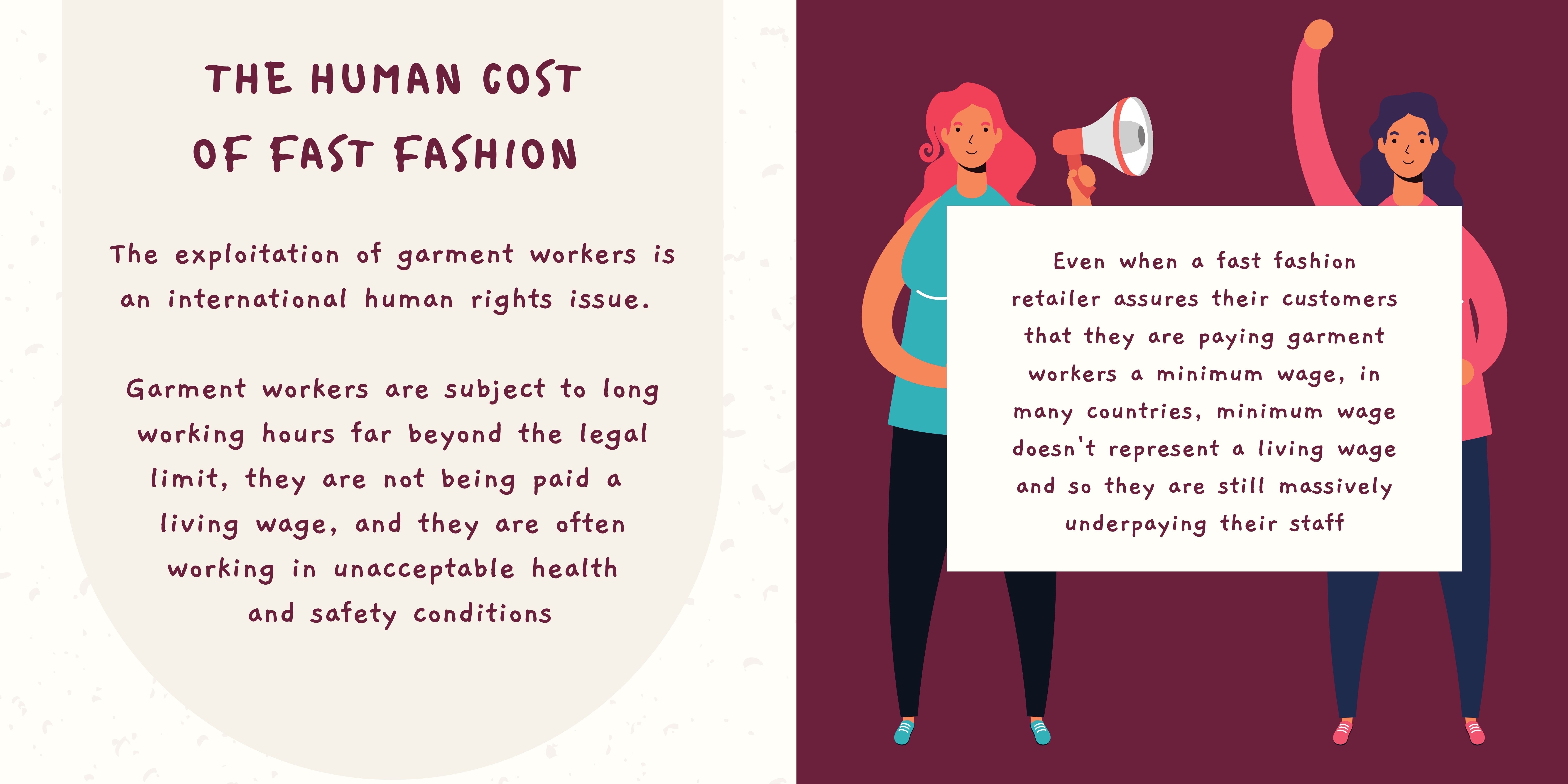
The Human Cost of Fast Fashion
As Lucy Siegle said: ‘Fast fashion is not free. Someone, somewhere is paying for it’. One in six people work in a fashion-related job[1] and the majority of these workers are women[2]. Most fast fashion companies outsource clothing production to countries with lax labour regulations[3] and exploit these lenient rules to maximise their profits[4].
The exploitation of garment workers is an international human rights issue. Garment workers are subject to long working hours far beyond the legal limit, they are not being paid a fair living wage, and they are often working in unacceptable health and safety conditions[5].
Even when a fast fashion retailer assures their customers that they pay their garment workers minimum wage, in many countries minimum wage doesn’t represent a living wage and so they are still massively underpaying their staff[6].
The 2013 Rana Plaza Disaster is a horrific example of the suffering that occurs in the fast fashion industry. 1138 people were killed and more than 2500 were injured when a garment factory building collapsed due to hazardous building conditions[1]. While their workers are suffering, these international brands bring in millions or even billions of euros of profit every year.
Forced and child labour is commonly found within the fast fashion industry[2]. A 2016 study found that 77% of companies in the UK think that it is likely that modern slavery is occurring in their supply chains[3]. The human rights violations that occur within the industry are outrageous and given that the majority of garment workers are women, it is women in the Global South that are being exploited the most by fast fashion.
No one should suffer just so you can look ‘trendy’.
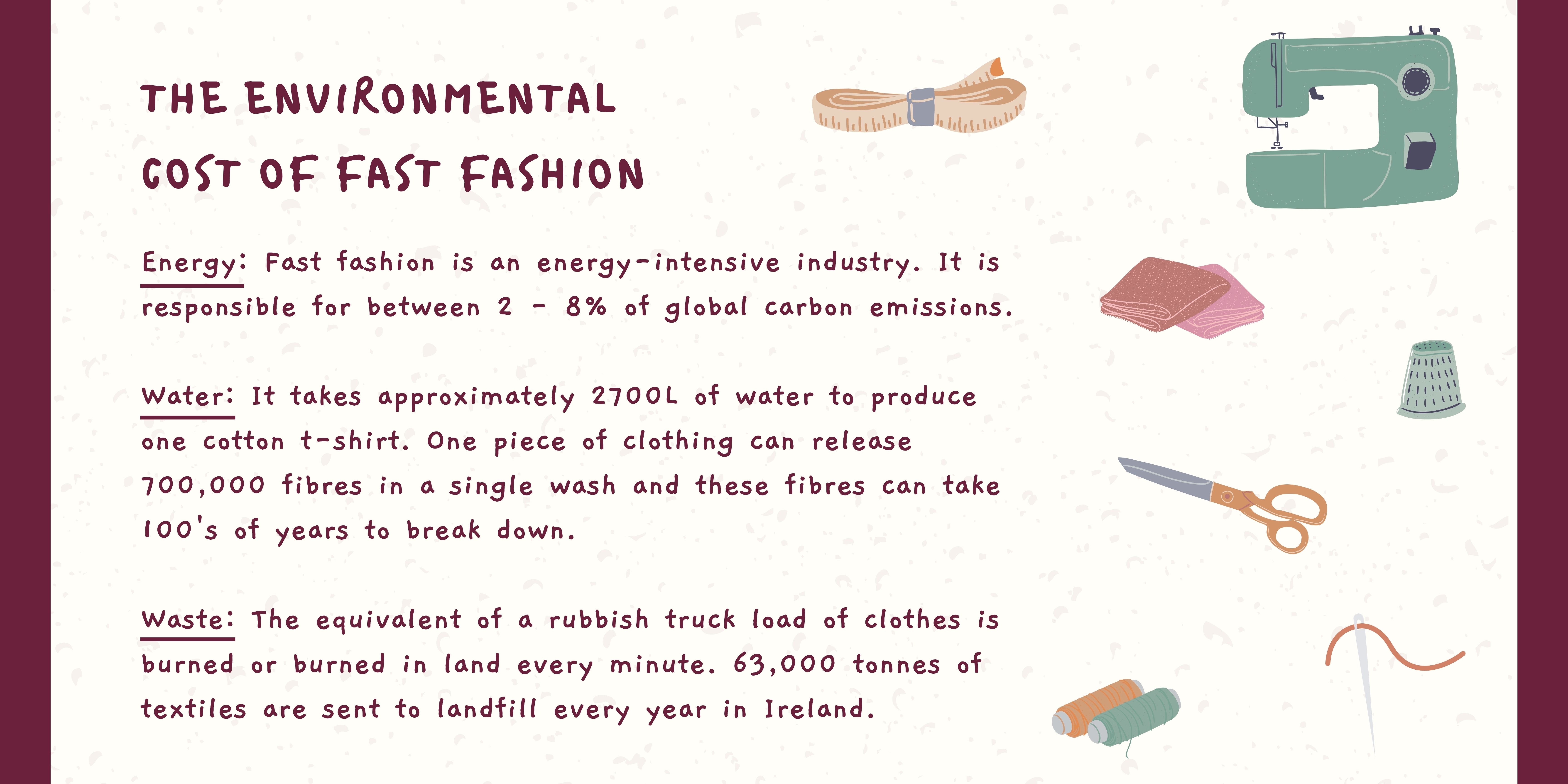
The Environmental Cost of Fast Fashion
The fast fashion industry has detrimental environmental impacts:
Energy: Fast fashion is an energy-intensive industry. It is responsible for between 2 - 8% of global carbon emissions[1]. The United Nations Framework Convention on Climate Change (UNFCCC) has said that emissions from the fast fashion industry is estimated to rise by more than 60% by 2030[2].
Water: Producing fast fashion garments is a water-intensive activity. It takes approximately 2700L of water to produce one cotton t-shirt (which is enough water to sustain one person for 3 years)[3]. It is also a significant contributor to micro fibres in our water supplies and oceans. One piece of clothing can release 700,000 fibres in a single wash and these fibres can take 100’s of years to
break down[1]. Textile dyeing is the second largest water polluter in the world and many brands use toxic chemicals and dyes that contaminate water supplies[2].
Waste: According to the Ellen MacArthur Foundation, the equivalent of a rubbish truck load of clothes is burned or burned in land every minute[3]. 63,000 tonnes of textiles are sent to landfill every year in Ireland[4]. To make matters worse, clothing production doubled between 2000 and 2014[5] and if we continue at our current rate, this cycle of overconsumption and waste will only get worse.
Fashion shouldn’t cost the earth.
Green Washing & Fast Fashion
With environmental issues coming to the forefront of international news and politics in recent years, many are calling for accountability and better environmental standards from fast fashion brands. Many companies have responded to these demands by performing sustainability instead of making much needed changes to their production practices.
Greenwashing involves a company or organisation making their business or activities seem more environmentally friendly than they really are. A prime example of this is H&M.
H&M has its own Conscious Collection which is pitched to be a more sustainable clothing line that uses leather alternatives like Piñatex sourced from pineapple leaf fibres[1], algae-generated footwear[1] and a citrus juice by-product to create silk-like fabrics[2]. It has been found that more than 60% of big fast fashion brands mislead customer with ‘flimsy sustainability claims’[3]. There is no legal significance to terms such as ‘ethical’ or ‘eco-friendly’ which makes it easier for brands to get away with greenwashing[4].
This brand runs a Garment Collection Programme that lets people drop off any unwanted textiles and claims to send them to a recycling centre. A 2015 H&M video campaign says ‘There are no rules in fashion but one: recycle your clothes’[5]. However, in reality, it’s likely that less than 1% of these garments are actually recycled[6]
You cannot produce and consume ethically when the entire system is corrupt. The fast fashion industry is a huge contributor to the current climate crisis and things must change if we want to create an equitable and sustainable world.
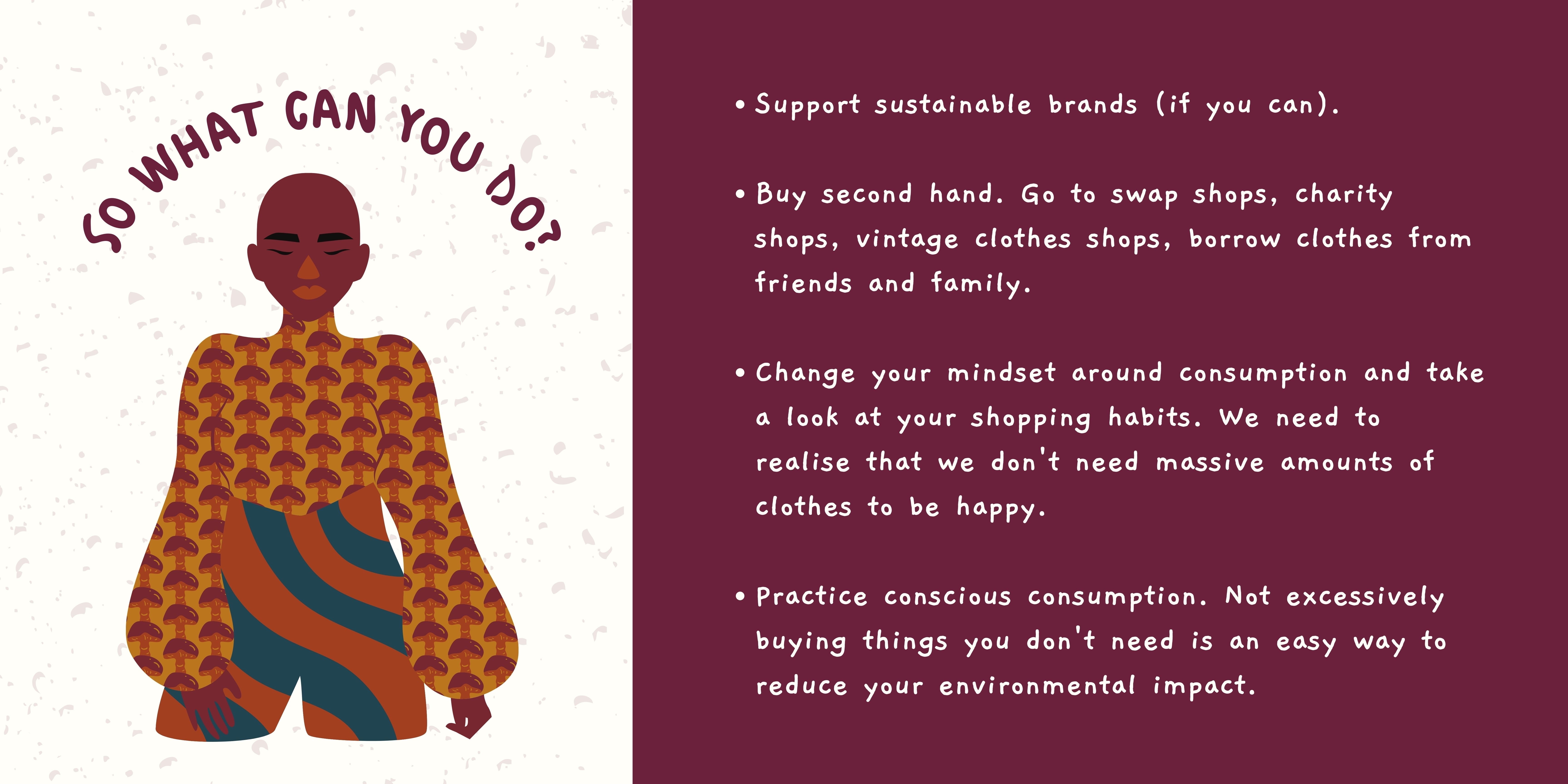
What should we do?
Well after hearing the harmful impacts of fast fashion on both people and the planet, should we all boycott fast fashion? Not necessarily.
Being able to boycott fast fashion and exclusively buy clothes from sustainable sources is a privileged position to be in. Sustainable fashion is more expensive than fast fashion as these brands pay their workers fair wages and source their materials through ethical and sustainable means. The costs associated with these clothes means that sustainable fashion is not accessible to everyone.
Buying secondhand clothing and thrifting in charity shops is a great way to avoid fast fashion. However, it can be difficult to find secondhand clothing in specific sizes whereas fast fashion brands are more likely to stock plus, petite, and tall ranges.
While we should all be doing our best to minimise our environmental impacts, to insist that everyone boycotts fast fashion and to shame anyone who does buy from these brands is taking a very narrow approach to a multifaceted issue.
Massive fast fashion corporations are responsible.
We need transparency and ethics to be at the centre of the fashion industry. Don’t let fast fashion brands convince you that consumers are the problem. They are the ones profiting off destruction and exploitation, not us.
Yes, consumers have the power to demand change. However, it is the responsibility of these companies to ensure that their products are having minimal environmental impacts and all of their workers are provided with safe working conditions and at the very least, a living wage.
For that to occur, the entire system needs to change.
A circular economy for fashion is the future. By creating a system built on equality and sustainability, we can protect garment workers and the environment. We need an industry that creates clothes that will last and that are made from safe and sustainably sourced materials that can be recycled or disposed of with minimal environmental impacts.
Conscious consumerism
There are some actions you can take in your everyday life to reduce your carbon footprint and support ethical fashion.
- Support sustainable brands (if you can).
- Buy second hand. Go to swap shops, charity shops, vintage clothes shops, or borrow clothes from friends and family.
- Change your mindset around consumption and take a look at your shopping habits. We need to realise that we don’t need massive amounts of clothes to be happy.
- Practice conscious consumption. Not excessively buying things you don’t need is an easy way to reduce your environmental impact.
It’s impractical to ask people to never buy new clothes again. Fashion at its core is about self-expression, art, and creativity, and it’s not something that should be abandoned. What we should strive for is thoughtful consumption. When you’re out shopping, don’t just buy a lot of clothes simply because you can, or the price is low.
As the saying goes, the most sustainable piece of clothing is the one you already own.
Climate justice means centring our systems around the well-being of people and our planet. This cannot be achieved under a system that prioritises economic growth and power. Ultimately, we need to decolonise and dismantle our oppressive and exploitative structures to avert the climate crisis. This includes the current model of the fast fashion industry.
See for further information:
Good on You is the world’s leading source for fashion brand ratings. They rate fashion brands on ethics and sustainability in a clear way to allow you to see through greenwashing techniques
Mina Le, ‘TikTok is Kind of Bad for Fashion’ https://youtu.be/JR3z8lq2cNM
Haute Le Mode, ‘ Fast Fashion Is Disgusting (you need to stop shopping at Fashion Nova, Zara and Primark’ https://youtu.be/8ox72V4DM2w
The New York Times, ‘Rana Plaza Collapse Documentary: The Deadly Cost of Fashion’ https://youtu.be/9Fkhzdc4ybw
[1] Lauren O’Neill, ‘A Five-Minute History of Fast Fashion in the UK’ Vice (25 February 2020) https://www.vice.com/en/article/v74z9x/fast-fashion-history-zara-topshop-boohoo-missguided
[2] Audrey Stanton, ‘What is Fast Fashion, Anyway?’ The Good Trade https://www.thegoodtrade.com/features/what-is-fast-fashion
[3] Veronique Greenwood, ‘Keeping Clothes Out of the Garbage’ Anthropocene
https://www.anthropocenemagazine.org/sustainablefashion/
[4] Riley Johnson, ‘How Social Media Affects the Fast Fashion Industry’ Untitled (23 April 2021)http://untitled-magazine.com/how-social-media-affects-the-fast-fashion-industry/
[5] A ‘haul’ is where someone buys a large amount of clothing and shows off each piece to their followers in a video. See for more information: ‘Our Dangerous Obsession with Huge Fashion Hauls’ Imperfect Idealist (27 March 2021) https://imperfectidealist.com/the-problem-with-fashion-hauls/
[6] United Nations Economic Commission for Europe, ‘Fashion and the SDGs: What Role for the UN?’ (UNECE)
https://unece.org/fileadmin/DAM/RCM_Website/RFSD_2018_Side_event_sustainable_fashion.pdf
[7] Labour Behind the Label, ‘Gender’ https://labourbehindthelabel.org/our-work/gender/
[8] House of Commons Environmental Audit Committee. ‘Fixing Fashion: Clothing Consumption and Sustainability’ 19 February 2019, page 12.
[9] Jason Malik Chua, ‘Why Is It So Hard for Clothing Manufacturers to Pay a Living Wage?’ Vox (27 February 2018) https://www.vox.com/2018/2/27/17016704/living-wage-clothing-factories
[10] House of Commons Environmental Audit Committee. ‘Fixing Fashion: Clothing Consumption and Sustainability’ 19 February 2019, page 12.
[11] Sustain Your Style, ‘Most of our clothes are made in places where workers rights are nonexistent’ https://www.sustainyourstyle.org/old-working-conditions
[12]International Labour Organisation, ‘The Rana Plaza Accident and it's aftermath’ https://www.ilo.org/global/topics/geip/WCMS_614394/lang--en/index.htm
[13] See for example: World Vision Action, ‘Forced and Child Labour in the Cotton Industry’ https://www.sustainyourstyle.org/old-working-conditions
[14] Ethical Trading Initiative & Hult International Business School, ‘Corporate Leadership on Modern Slavery’ (2016) page 8.
[15] United Nations Environment Programme, ‘Putting the brakes on fast fashion’ https://www.unep.org/news-and-stories/story/putting-brakes-fast-fashion
[16] United Nations Framework Convention on Climate Change, ‘Fashion Industry, UN Pursue Climate Action for Sustainable Development’ https://unfccc.int/news/fashion-industry-un-pursue-climate-action-for-sustainable-development
[17] WWF, ‘The Impact of a Cotton T-Shirt’ https://www.worldwildlife.org/stories/the-impact-of-a-cotton-t-shirt
[18] Greenpeace, ‘What are microfibres and why are out clothes polluting the oceans?’ https://www.greenpeace.org/international/story/6956/what-are-microfibers-and-why-are-our-clothes-polluting-the-oceans/
[19] Ibid.
[20] Ellen MacArthur Foundation, ‘Redesigning the future of fashion’
https://ellenmacarthurfoundation.org/topics/fashion/overview
[21] Carolyn Moore, ‘Cheap clothes are cheap clothes, but fast fashion is the real environmental problem’ The Journal (9 September 2020)
https://www.thejournal.ie/readme/cheap-clothes-and-fast-fashion-5198063-Sep2020/
[22] Nathalie Remy et al. ‘Style that’s sustainable: A new fast fashion formula’ https://www.mckinsey.com/business-functions/sustainability/our-insights/style-thats-sustainable-a-new-fast-fashion-formula
[23] Olivia Petter, ‘H&M used pineapple leaves and orange peel in its latest conscious collection’ Independent (18 April 2019) https://www.independent.co.uk/life-style/fashion/hm-conscious-exclusive-collection-pineapple-orange-peel-spring-2019-a8865341.html
[24] H&M, ‘Surf’s up! H&M head to the beach with a more sustainable kids collection’ 20 MAy 2021 https://about.hm.com/news/general-news-2021/surf-s-up--h-m-heads-to-the-beach-with-a-more-sustainable-kids-c.html
[25] H&M, ‘Orange Fibre’ 26 March 2019 https://hmgroup.com/our-stories/orange-fiber/
[26] Hannah Westwater, ‘Fashion brands ‘routinely’ mislead the public over their green credentials’ The Big Issue (29 June 2021) https://www.bigissue.com/latest/fast-fashion-greenwash-misleading-shoppers-and-upping-plastic-pollution
[27] Mehar Mehar, ‘The deception of greenwashing in fast fashion’ Down To Earth (16 February 2021)
https://www.downtoearth.org.in/blog/environment/the-deception-of-greenwashing-in-fast-fashion-75557
[28] H&M Conscious: Sustainable fashion through recycled clothes https://youtu.be/s4xnyr2mCuI
[29] Zara Ramaniah, ‘H&Ms Greenwashing: Short-Sighted and Unethical’ Branding Mag (12 December 2019)
https://www.brandingmag.com/2019/12/12/hms-greenwashing-short-sighted-and-unethical/
